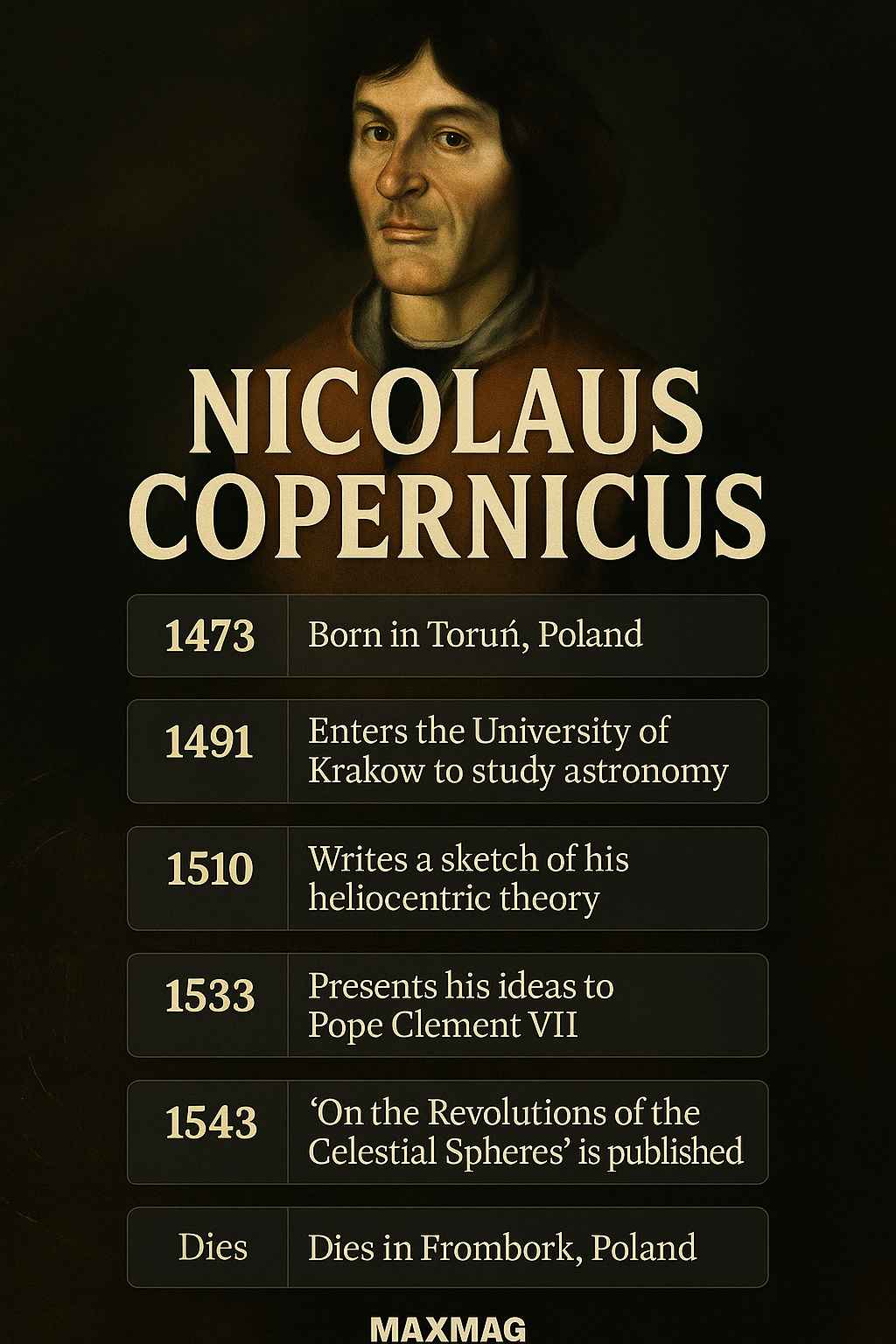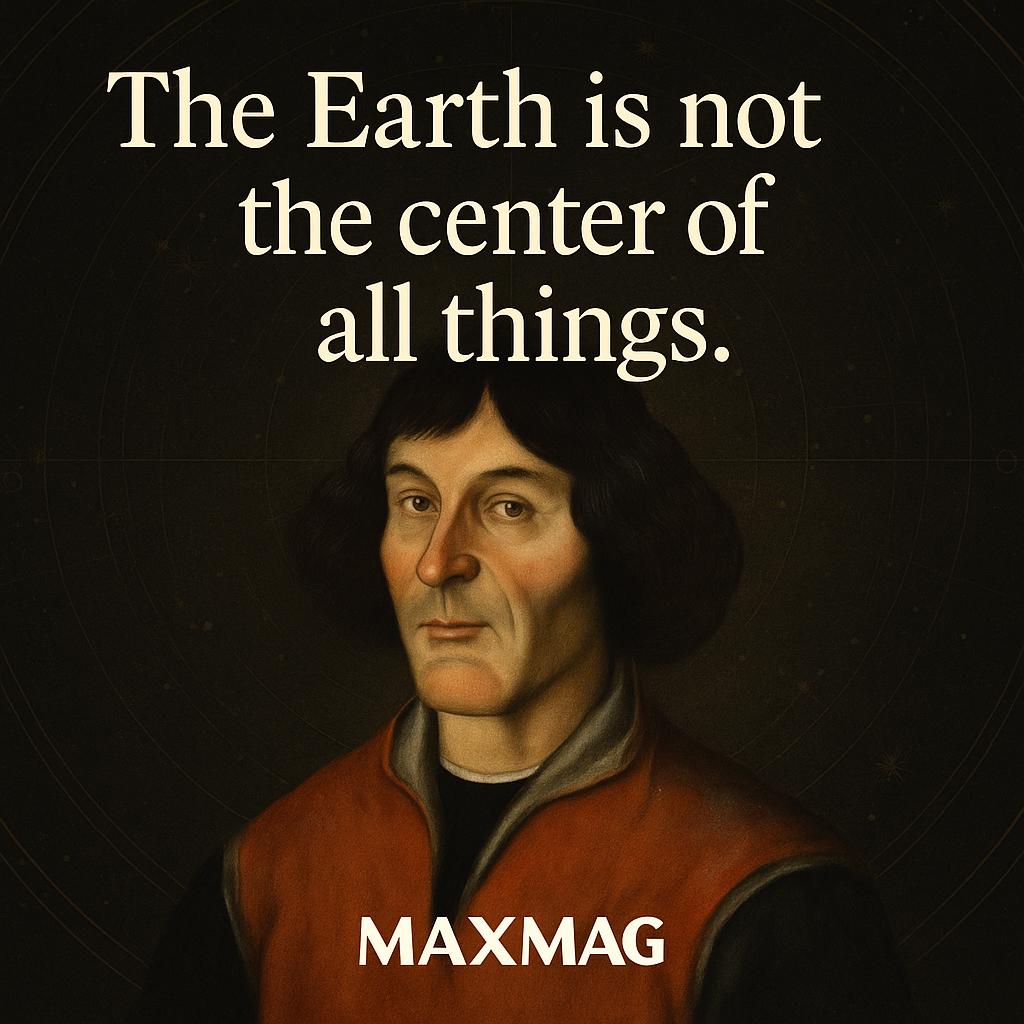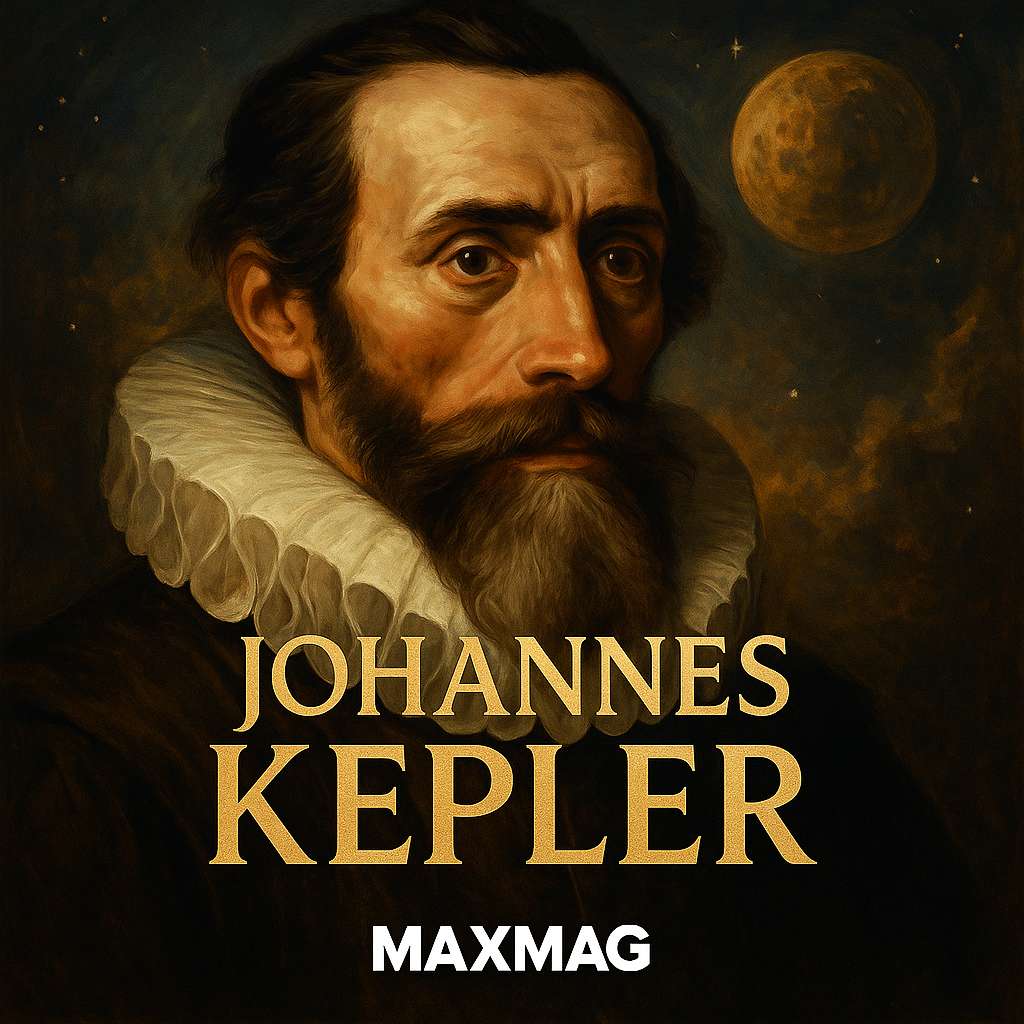
On a cold Baltic night in the early 1500s, a church canon climbed wooden stairs to a small tower overlooking the Vistula Lagoon, carrying nothing more dramatic than a notebook, a quadrant, and an irritatingly persistent question. The stars above Warmia did what they had always done: they rose, slid westward, and set. But Nicolaus Copernicus watched them with a kind of quiet unease that would not let go. This Nicolaus Copernicus biography is the story of a man who lived inside the routines of a cathedral chapter yet slowly, stubbornly, and almost reluctantly rewired the place of Earth in the cosmos.
Copernicus did not topple an empire with a manifesto or a telescope. He was trained as a lawyer, employed as an administrator, and valued as a physician. Astronomy was his long obsession, pursued in the hours left over from civic duty. The heliocentric theory that made him famous grew in the margins of calendars, legal files, and medical visits, and it reached print only as his body failed. A good Nicolaus Copernicus biography therefore isn’t just a tale of genius; it is a tale of patience, hesitation, and a world that was ready for new ideas but unsure how to live with them.
At a glance:
- Who: Nicolaus Copernicus (1473–1543), Polish Renaissance astronomer, mathematician, and canon of Warmia.
- Era: The European Renaissance, when revived classical learning met entrenched religious authority and a fast-changing economy.
- Headline contribution: A Sun-centred solar system laid out in De revolutionibus orbium coelestium (1543).
- Why he matters today: The Copernican Revolution shaped the history of astronomy and helped define how modern science evaluates old assumptions.
Early Life and Education of Nicolaus Copernicus
Nicolaus Copernicus was born on February 19, 1473, in Toruń, a bustling trading city on the Vistula River. Toruń sat on borders that were political, linguistic, and commercial; German merchants and Polish nobles shared its markets, and the Hanseatic League’s routes fed its wealth. Copernicus’s father, also named Nicolaus, made his living in copper trade. His mother, Barbara Watzenrode, came from a prominent local family. When Copernicus was about ten, his father died, and the boy’s future turned on the careful ambition of his maternal uncle, Lucas Watzenrode, who would later become Bishop of Warmia.
Watzenrode recognised both talent and opportunity. He secured his nephew a canonry in Frombork Cathedral—essentially a salaried clerical-administrative post—and planned to mould him into a useful churchman. Before Copernicus could take up the office fully, though, he needed an education. Around 1491 he arrived at the University of Kraków. There, astronomy belonged to mathematics: students learned Euclid, Aristotle’s natural philosophy, and the Ptolemaic cosmos. Kraków also hosted one of Europe’s most active communities of astronomers, who argued over drifting planetary tables and the messy problem of calendar accuracy. The young Copernicus learned the old system with a scholar’s respect, but he also learned that even respected systems could fail in practice.
In 1496, Watzenrode sent Copernicus to Italy for advanced study. Bologna came first, to take canon law. There Copernicus lodged with Domenico Maria Novara, an astronomer who observed the sky with an independence that was still rare. Copernicus joined him on night walks of calculation and measurement—scenes of cold air, candlelight, and the mild thrill of seeing the heavens as a project rather than a given.
From Bologna he moved to Padua to study medicine. It was practical training: a cathedral chapter needed its own doctor, and Watzenrode wanted his nephew to be indispensable. Finally, at Ferrara in 1503, Copernicus earned a doctorate in canon law. He returned to Warmia in his early thirties a fully formed Renaissance professional: fluent in Latin, able to read Greek sources, competent in law and medicine, and thoroughly trained in the astronomy of his time. This grounding matters, because the later Nicolaus Copernicus biography is not the story of a wild outsider. It is the story of someone made by institutions who learned to interrogate their tools.
Section wrap-up: Copernicus’s early life produced a hybrid mind—part churchman, part civic servant, part mathematician—ready to question the cosmos without abandoning his world.

Nicolaus Copernicus biography and the Birth of His Big Ideas
A quiet dissatisfaction with the Ptolemaic system
For more than a thousand years, European astronomy had depended on Claudius Ptolemy’s Earth-centred cosmos. It was elegant in a certain way: Earth at the center, planets moving on perfect circles, stars fixed on an outer sphere. Yet elegance was maintained by heavy repairs. When Mars, Jupiter, or Saturn appeared to reverse direction—retrograde motion—Ptolemy explained the trick by layering circles on circles: epicycles rotating on deferents. The math could be made to work, but the system was starting to resemble a clock packed with too many gears.
Copernicus returned to the Almagest repeatedly, not as a worshipper but as a craftsman looking for a cleaner design. If the universe was rational, its rules should be simple. His philosophical instinct toward symmetry met a practical problem: tables based on Ptolemy no longer lined up with certain conjunctions and eclipses as neatly as they once had. The model predicted, but it did not persuade.
The Commentariolus: a theory before the book
Sometime around 1510, after settling in Frombork, Copernicus drafted a short anonymous outline now called the Commentariolus. He shared it privately with a small circle of astronomers. The manuscript opened with seven axioms and a dramatic rearrangement: the Sun, not Earth, sits near the center; planets orbit it; Earth rotates daily; Earth also makes a yearly circuit; the apparent motion of the Sun through the zodiac is an effect of Earth’s movement.
His key move was as human as it was mathematical. Picture two runners on a track. When the inner runner overtakes the outer one, the outer runner can appear to drift backward relative to you, even though both are moving forward. Copernicus applied that everyday logic to the sky. Mars does not truly reverse; Earth passes it. The clumsy tangle of epicycles suddenly loosened.
The Commentariolus did not try to win an audience. It tried to test a hunch. But the hunch was already a revolution waiting for a door to open. This Nicolaus Copernicus biography turns on that moment of private clarity: the decision to believe your own arithmetic even when it says you are standing on a moving world.
Section wrap-up: Copernicus’s big idea began not as rebellion, but as repair—an attempt to make astronomy simpler and more truthful.
Key Works and Major Contributions of Nicolaus Copernicus
De revolutionibus orbium coelestium
Copernicus expanded his private outline into a full planetary system over decades. He checked old observations, performed new ones, and rebuilt tables in the slow rhythm of someone who knew he could not afford a public mistake. His instruments were naked-eye devices: quadrants, armillary spheres, and sighting rods. No telescope would come for another half-century. Yet he trusted mathematics as a kind of x-ray for the sky.
The result was De revolutionibus orbium coelestium (“On the Revolutions of the Heavenly Spheres”), printed in Nuremberg in 1543. In six dense books, Copernicus laid out the heliocentric model, explained planetary order by orbital periods, and provided new tables for prediction. He still assumed circular orbits and retained small epicycles to match data—errors that later astronomers would correct. But the structure was transformed: Earth was a planet in motion.
A famous story says a copy was placed in Copernicus’s hands after he collapsed from a stroke and that he woke briefly to recognise it before dying. Whether embellished or not, the timing is right. He published at the last possible moment.
Beyond astronomy: calendar and coins
Copernicus was not an astronomer in a vacuum. The Church depended on accurate solar and lunar cycles to keep the liturgical calendar—especially Easter—from drifting. Copernicus was consulted in early discussions that eventually led to the Gregorian reform, even though the final correction came decades after his death.
He also wrote Monetae cudendae ratio (1526), a treatise on monetary policy. In brisk, practical prose, he argued that debased currency weakens economies and destabilises states. It is easy to miss this side of him in a simplified Nicolaus Copernicus biography, but it matters: the same mind that hated arbitrary epicycles in the sky also hated arbitrary adulteration at the mint.
Section wrap-up: Copernicus’s contributions ranged from stars to statecraft; heliocentrism was his masterpiece, not his only craft.

Methods, Collaborations and Working Style
An astronomer without a telescope
Copernicus’s nightly routine was modest and relentless. From his tower at Frombork, he measured solar altitudes, lunar positions, and planetary conjunctions. He compared what he saw against established tables, searching for patterns rather than anomalies. When mismatch appeared, he did not throw the data away; he questioned the assumptions beneath it. His revolution was as much about method as about model.
Rheticus and the decision to publish
Even a solitary thinker needs a messenger. Georg Joachim Rheticus, a young mathematician from Wittenberg, arrived in Frombork in 1539 after hearing rumours of Copernicus’s system. He stayed two years, studied the manuscript, and wrote Narratio Prima, an enthusiastic summary that circulated across Europe. It was the first real public announcement of heliocentrism. Rheticus then persuaded Copernicus to let the full book go to print and carried the manuscript to Nuremberg himself.
While Rheticus was away, Andreas Osiander inserted an unsigned preface claiming the heliocentric system should be read only as a calculating convenience, not a statement about the true structure of the world. He meant to soften conflict, but he also blurred Copernicus’s intention for years.
Copernicus’s working style comes into focus here: meticulous, wary of noise, and inclined to trust a small circle rather than the public marketplace of ideas.
Controversies, Criticism and Misconceptions
Nicolaus Copernicus biography and the question of fear
The popular version says Copernicus hid his theory because he feared the Catholic Church. It makes a neat modern morality tale. The historical record is messier. Copernicus dedicated De revolutionibus to Pope Paul III, and in his lifetime heliocentrism was not formally condemned. Many early readers were churchmen. Resistance that did arise came from multiple directions, including astronomers committed to Aristotelian physics. If Earth moves, they asked, why don’t we feel the rush? Why don’t stones tossed upward land behind us? These were physical objections, not just theological ones.
Copernicus likely feared ridicule more than prosecution. Astronomy was a small republic of letters. To propose a moving Earth without a physical mechanism was to invite cutting critique. He was cautious by temperament, and his job rewarded caution.
What Copernicus did not prove
Another myth is that Copernicus “proved” heliocentrism conclusively. He did not. He argued that it was simpler and more coherent than the Ptolemaic system. Decisive observational support came later. Galileo’s telescope revealed moons orbiting Jupiter and the phases of Venus, observations that fit more naturally in a Sun-centred world. Kepler then replaced Copernicus’s circles with ellipses, and Newton explained the gravitational force behind orbits.
This matters because it shows how scientific revolutions actually work: not by a single slam-dunk proof, but by a better framework that gathers evidence around itself over time.
Section wrap-up: The controversy inside this Nicolaus Copernicus biography is less about persecution and more about slow persuasion—of colleagues, of culture, and of common sense.
Impact on Astronomy and on Wider Society
The Copernican Revolution as a turning point
De revolutionibus was not an instant bestseller. Its technical Latin limited the audience to specialists. Yet specialists teach students, write letters, and build instruments. By the late sixteenth century, heliocentrism was a live scientific option. Tycho Brahe proposed a hybrid compromise; Kepler, working from Tycho’s observations, discovered elliptical orbits; Galileo supplied telescopic drama; Newton tied the system together with gravity. In that chain, Copernicus is the first domino.
Just as important, he changed what counted as a good explanation. Before Copernicus, astronomy was often a toolkit to “save the appearances.” After him, it became legitimate to ask what the heavens truly are. Prediction was no longer enough; structure mattered.
Rewriting humanity’s self-image
A moving Earth did cultural work. It loosened the metaphor of humanity sitting at creation’s centre. Philosophers and theologians had to adjust their mental maps. The heliocentric idea helped feed the broader scientific revolution, where observation and mathematics gradually outranked inherited authority.
For a crisp historical overview of how planetary motion and heliocentrism evolved from Copernicus through Galileo, you can read NASA’s history of planetary motion and the heliocentric idea.
Section wrap-up: Copernicus moved planets in theory, but in practice he moved Europe’s intellectual centre.

Personal Beliefs, Character and Private Life
A churchman and civic servant
Copernicus was a cleric but not a priest. As a cathedral canon he administered estates, mediated disputes, and represented Warmia in negotiations with the Teutonic Order and the Polish Crown. During a siege in 1520, he helped organise defenses and supplies—an entirely terrestrial kind of orbit. He also treated patients, including the poor, with the quiet authority of a trained physician. These duties tethered him to community and likely sharpened his instinct for discretion.
His surviving letters and prefaces suggest a man devoted to harmony—mathematical and moral. He frequently invoked order, proportion, and intelligibility. He seems to have preferred persuasion to provocation, and clarity to spectacle.
Rumours, companionship, and silence
Because Copernicus left little personal confession, biographers have filled the gaps with speculation. Local records hint that he kept company with a woman named Anna Schilling, perhaps as a housekeeper, perhaps as a partner. In the late 1530s a church visitor reprimanded Copernicus for her presence; he complied and she disappears from the archive. The evidence is thin, and historians disagree on what it means. What it shows at minimum is that he guarded his private orbit carefully, unwilling to feed gossip that might distract from his work.
Later Years and Final Chapter of Nicolaus Copernicus
In his fifties and sixties, Copernicus’s responsibilities grew heavier. He oversaw finances, advised local rulers, and continued to refine astronomical parameters. His health weakened slowly, probably through strokes and vascular illness. Yet the work never truly stopped. The final revisions of De revolutionibus were the product of a mind still chasing consistency while the body faltered. Another mention in this Nicolaus Copernicus biography is unavoidable: he lived long enough to perfect his argument and just long enough to release it.
Copernicus died on May 24, 1543, and was buried in Frombork Cathedral. Centuries later, archaeologists identified his remains through DNA and forensic reconstruction, a modern recovery of a Renaissance mind.
The Lasting Legacy of Nicolaus Copernicus biography
Nicolaus Copernicus biography and the new standard of explanation
Copernicus’s influence is often summarised as “the Sun is the centre.” But his deeper legacy is methodological. He demonstrated that scientific models should be judged by coherence and explanatory power, not by how comfortably they fit tradition. He showed that the simplest story can be the most radical, and that long-trusted systems can be respected and still revised.
This is why “Copernican Revolution” now travels far beyond astronomy. It has become shorthand for any shift that dislodges a presumed centre—psychological, political, or scientific. That metaphor exists because he first built a disciplined model that changed the history of astronomy.
How we remember him now
Every era rewrites Copernicus to suit its debates. In the nineteenth century he was cast as a hero of reason against faith. More recent scholarship emphasises continuity: Copernicus drew on Ptolemaic mathematics, Renaissance astronomy, and earlier Islamic innovations as much as he broke from them. A balanced modern narrative of his breakthrough and reluctance appears in National Geographic’s feature on Copernicus’s revolutionary reorganization of the heavens.
What remains uncontested is the scale of the shift. Once Earth moves in imagination, everything else can move too: theology can stretch, politics can decentralise, philosophy can re-rank certainty. The heliocentric theory reminds us that perspective is part of truth.
In that sense, the Nicolaus Copernicus biography is not only about a man with a quadrant on a tower. It is about the courage to accept that we may not be where we think we are—and to keep calculating anyway. The Sun still rises, Earth still spins, and the quiet insistence of his work still guides how we test the world.
Frequently Asked Questions about Nicolaus Copernicus biography
Q1: What did Nicolaus Copernicus actually discover?
Q2: Was Copernicus the first to suggest heliocentrism?
Q3: Why did Copernicus wait so long to publish De revolutionibus?
Q4: How did Galileo and Kepler relate to Copernicus’s work?
Q5: Did the Catholic Church immediately oppose Copernicus?
Q6: What is the Copernican Revolution?




